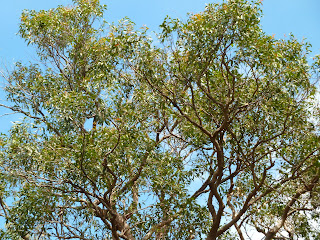Brisbane has been enveloped in smoke haze for days, the result of a 'spate of blazes' (Courier Mail), aided and abetted by a ridge of high pressure. It has produced oddly pink dawns (below) and veiled sunsets. Interesting, but strange. By day the sky has been bland, not blue.

I don't particularly remember news of bushfires last year – which probably had something to do with the enormous quantities of rain dumped regularly – but no one should forget Black Saturday in February 2009, when 173 people lost their lives in Victoria.
So, bushfires are common in this land of low, often unreliable rainfall and drought. A drought followed by extensive rain – which is exactly what has happened in Australia recently – allows luxuriant grasses to grow back, and grasses are the 'fuel' of bushfires.

In addition, many native plants are particularly vulnerable: the oil in eucalyptus trees, for instance, makes them burn more easily.

Relative humidity and wind speed are also significant. Australia spans many latitudes so weather systems featuring highs and lows and fronts vary from one region to another. But a common constituent of fire-alert weather is a hot dry wind blowing from the interior. The winds ahead of and behind a cold front, too, can greatly affect the progress, or otherwise, of a fire already raging.
Bushfires are started in a number of ways. Lightning is a common natural cause. There are many unnatural ones – camp fires, dropped cigarettes and matches, machinery, agricultural clearing and controlled 'burnoffs'*, and arson. Indigenous Australians used controlled burns to clear tracks and increase grassland for hunting. Their mosaic burning practices, adopted by settlers, encouraged plant regeneration. Some plants need fire: the seed pods of banksias, for example, are split open by fire so the seeds can germinate.
As with all threats from their harsh surroundings, Australians have systems in place to deal with the dangers posed. The Bureau of Meteorology** issues forecasts (Fire Weather Warnings) to fire authorities so that they can determine the Fire Danger Rating (FDR), which is posted on highways and publicised by the media. They announce Total Fire Bans if the FDR is above low-to-moderate risk.
Authorities remain on high alert across Queensland. The Mail reports today that fire crews have dealt with nearly 150 vegetation fires in the last 24 hours. They build firebreaks and carry out back-burning, which means they start small fires ahead of the main fire front to reduce the amount of flammable material available when it gets there.
The skies are slowly clearing in Brisbane but, after so many dry and sunny weeks since June, the fire threat will presumably remain high until the summer rains.

* the controlled burning of dead wood, leaves, broken branches, undergrowth and other debris that, if left lying on the ground, would feed a fire
** BOM is also a good source of information about bushfires: http://www.bom.gov.au/weather-services/bushfire/about-bushfire-weather.shtml







No comments:
Post a Comment